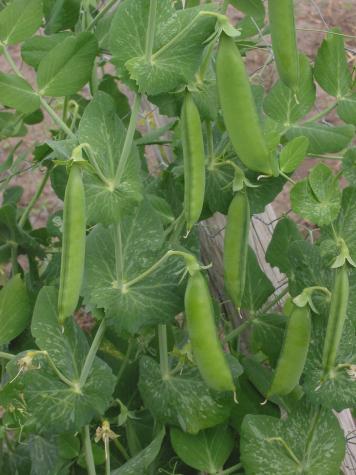A culinary delight from the garden.
COLUMBIA, Mo. – No other vegetable is as closely associated with a month of the year as is garden pea, and few things match the gastronomic appeal of fresh peas from the garden. The term “early June peas” often appears on labels to indicate they are young and still have a high sugar content, said University of Missouri Extension horticulturist David Trinklein. Peas are sweetest when they mature in cool weather, before too much of the sugar they contain converts into starch.
For the same reason, peas that mature in cool weather are tastier than those harvested after temperatures rise, so this cool-season vegetable needs to be planted early, Trinklein said.
“A problem in Missouri is we can quickly go from cool spring temperatures to warm summer weather in seemingly a matter of days,” he said. “Therefore, once the soil warms, the earlier peas are planted in the spring the better.”
People have cultivated peas for more than 5,000 years. In ancient times, peas were allowed to mature and were harvested as dry peas. Dry peas were cooked in water to form a soup or porridge. The English nursery rhyme “Pease Porridge Hot” refers to this custom.
Today, the term pea refers to Pisum sativum, or garden pea, which is eaten when green and immature. Snap pea and sugar (snow) pea represent biotypes of the species whose entire pod can be consumed when harvested at an early stage of maturity.
Garden peas tolerate light frosts and can germinate in relatively cool soils. Peas prefer a well-drained garden loam with a pH between 6.0 and 6.5. Sow seeds directly in the soil about an inch deep and 2 inches apart in rows spaced 18-24 inches apart.
Fertilizer application should be based on soil tests. Apply before planting seeds. Like other legumes, peas (with the aid of symbiotic bacteria) can fix atmospheric nitrogen. However, if plants appear light green or yellow after pods begin to set, apply a side dressing of nitrogen. Peas prefer soil that is uniformly moist but not wet.
Several varieties of garden pea do well in Missouri, said Trinklein. Popular choices include Spring (57 days to harvest, 22 inches tall), Sparkle (60 days, 18 inches tall), Little Marvel (63 days, 18 inches tall), Lincoln (67 days, 30 inches tall), Green Arrow (68 days, 28 inches tall), Bolero (69 days, 28 inches tall) and Wando (70 days, 30 inches tall).
Taller varieties need 3 feet between rows and some method of trellising or support. Dwarf varieties can be sown closer together and normally do not need to be trellised.
Peas are relatively pest-free, but aphids, leafhoppers and seed corn maggots can cause problems, said Trinklein. Diseases that can be troublesome include fusarium wilt, powdery mildew, root rot and seed rot. Powdery mildew can be especially troublesome in poorly drained soil or during wet springs. Rotating planting location in the garden from year to year helps in managing diseases of peas.
Depending on cultivar, planting date and seasonal temperatures, peas usually are ready for harvest about the middle of June, said Trinklein. Harvest normally lasts about two weeks. Timing the harvest is critical for top eating quality. Pick the pods as soon as they have swollen (appear round). Peas allowed to mature on the plant too long tend to convert sugars to starch, making them less sweet.
Peas often get a bad rap for being somewhat high in calories because of their sugar and starch content. However, those calories do come with fringe benefits. One-half cup of cooked peas contains 67 calories, 2.4 grams dietary fiber, 4.3 grams protein, 12.5 grams carbohydrates, 478 IU vitamin A, 11.4 mg vitamin C, 50.7 micrograms folic acid, 1.2 mg iron, 217 mg potassium and 31 mg magnesium.
For those whose appetite for fresh peas was not satiated by the spring crop, you can plant again in late summer for fall peas, which mature during cooler weather and usually are exceptionally tasty.
